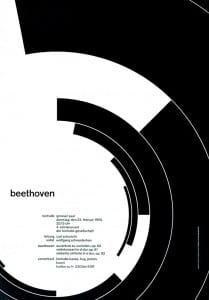International Typographical Style: Modernism Lecture
Todays lecture talked a lot about Helvetica and the varied views different designers have on it. I’ve always looked at Helvetica to be a plain, simple and dull typeface. However, after seeing the work of Josef Muller Brockmann, I changed my mind.
 His design is so simple yet effective by the way he has used Helvetica. He uses no uppercase lettering which creates a certain style and image. The way that ‘beethoven’ has not been made a big deal for example, by blowing it up, it has drawn more attention to it. The background design also draws attention to it by the way it is shaped. I love the clarity of this poster and it’s minimalism is refreshing.
His design is so simple yet effective by the way he has used Helvetica. He uses no uppercase lettering which creates a certain style and image. The way that ‘beethoven’ has not been made a big deal for example, by blowing it up, it has drawn more attention to it. The background design also draws attention to it by the way it is shaped. I love the clarity of this poster and it’s minimalism is refreshing.
Josef Mullar Brockmann, 1955, ‘Beethoven’
We also watched an extract from ‘Massimo Viginelli: Film Helvetica’. Viginelli explains how he disagrees that type should be expressive and this is why he likes Helvetica. However, I disagree with him as I feel that, especially with the range of type there is these days, all type is expressive and has a certain effect on a design.
However I do like what Brockmann has done with his design and I think I will try to incorporate my own typeface into a minimalist design like this to see if I can create a similar effect.